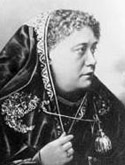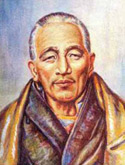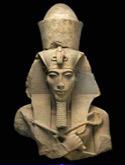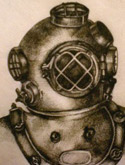Charlemagne Charles the Great: Holy Roman Emperor
April 2, 742, Aachen, Germany. (Speculatively 12:30 LMT, according to Marc Penfield.)
Died, January 28, 814, Aix-la-Chapelle, or Aachen, Austria.
(Ascendant, Leo with Saturn in Leo, H1; MC in Aries with Sun, Venus and Jupiter all conjunct in Aries, Sun and Venus loosely conjunct to the MC; Moon in Capricorn; Mercury in Pisces conjunct Chiron; Mars in Gemini; Uranus in Aquarius conjunct Descendant; Neptune in Taurus; Pluto in Libra.)

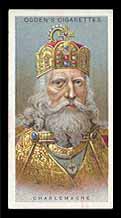 Charlemagne was the grandson of Charles Martel who saved France from the predations of Arab armies. In 768 Charlemagne became king of the Franks. We see that the Sun, Moon and Rising Sign are placed in the three signs which convey the first ray. Aries, his Sun Sign, is the pre-eminent sign of the first ray. When, in the case of a first ray soul, the Sun is conjunct the Midheaven, as it is here, tremendous authority is conferred. Charlemagne was a great military leader. Pluto in Libra, Mars (the “God of War” and exoteric ruler of his Aries Sun) and Uranus (the planet of electric will) are in a grand trine expressing ease of expression. The main concern of Charlemagne was to spread Christianity.
Charlemagne was the grandson of Charles Martel who saved France from the predations of Arab armies. In 768 Charlemagne became king of the Franks. We see that the Sun, Moon and Rising Sign are placed in the three signs which convey the first ray. Aries, his Sun Sign, is the pre-eminent sign of the first ray. When, in the case of a first ray soul, the Sun is conjunct the Midheaven, as it is here, tremendous authority is conferred. Charlemagne was a great military leader. Pluto in Libra, Mars (the “God of War” and exoteric ruler of his Aries Sun) and Uranus (the planet of electric will) are in a grand trine expressing ease of expression. The main concern of Charlemagne was to spread Christianity.
This motive bespeaks the presence of the sixth ray. Indeed we see the two sixth ray planets (Mars and Neptune) widely conjunct (8º), and Vesta, a major asteroid partially connected with the devotion and commitment of the sixth ray, is in the Mars-ruled sign, Aries, conjunct the MC. By extending his domains, he hoped also to widen the influence of the Christian Religion. We notice that his Aries planets, Sun, Venus and Jupiter are all conjunct or widely conjunct in H9 where religious/spiritual quests and expansions of the scope of the self are undertaken; it is the Sagittarian house.
Charlemagne was a reformer; notice that the hierarchical ruler of Aries, Uranus, is conjunct the seventh or Libran house cusp which social reform is undertaken. Much of the first and seventh ray flows through Uranus, and so, for him, this planet represents the Shamballa Force in its organizational and re-organizational aspect. Uranus is not only the hierarchical ruler of his Aries Sun but the veiled hierarchical ruler of his Leo Ascendant so it is, for Charlemagne, a very important planet (especially as it is placed in its own sign, Aquarius, stimulating the possibility of cultural reformation). While it is permissible to use the hierarchical rulers only in connection with confirmed initiates of the third degree (or those for whom this initiation is imminent), Charlemagne was certainly at least a prominent disciple upon the first ray. His importance to European civilization and culture is indisputable, and he became a great agent for constructive social and educational change (this capacity strengthened by the prominent Uranus). His commitment to Christianity, his sincerity, piety and real humility mark him as an initiate of some degree. It would seem that he had “met the Christ” and was at least an initiate of the first degree and perhaps of the second. In his amassing of power, principle played an important role.
 There are similarities between Charlemagne and Akbar the Great of India. Charlemagne is thought to have been illiterate (not unintelligent, but incapable of reading); the same is true, so it is said, of Akbar. Charlemagne, like Akbar, welcomed numerous scholars and artists to his court and encouraged education. He helped the monasteries and improved the legal system (Uranus at the seventh house of law and legality). His beneficent orientation was supported by the Sun and two “benefic” planets, Jupiter and Venus (all three of which express the second ray in one aspect or another of their energy system), all found in the ninth house of higher education, religion and legal perspective. The improvement of the legal system is reinforced by Uranus, the planet which, at its best, seeks improvement in any field of experience to which it may be related. In the seventh house, Uranus would be focussed on law, legality and improved human relations.
There are similarities between Charlemagne and Akbar the Great of India. Charlemagne is thought to have been illiterate (not unintelligent, but incapable of reading); the same is true, so it is said, of Akbar. Charlemagne, like Akbar, welcomed numerous scholars and artists to his court and encouraged education. He helped the monasteries and improved the legal system (Uranus at the seventh house of law and legality). His beneficent orientation was supported by the Sun and two “benefic” planets, Jupiter and Venus (all three of which express the second ray in one aspect or another of their energy system), all found in the ninth house of higher education, religion and legal perspective. The improvement of the legal system is reinforced by Uranus, the planet which, at its best, seeks improvement in any field of experience to which it may be related. In the seventh house, Uranus would be focussed on law, legality and improved human relations.
It is said of Charlemagne that he respected art and encouraged crafts workers to settle and work his lands. Here we see the effect of the Sun/Venus conjunction in Aries. Venus, let it be remembered, is, among other things, the planet of art, and conveys the culturing and uplifting influence of the Solar Angel.
Charlemagne’s court at Aachen became the seat of an intellectual and cultural renaissance. Here, again, we see the influence of the Sun/Venus conjunction and the stellium of planets in the ninth house (the house of philosophy and higher mind).
Charlemagne was a great patron of education (showing his deep link to the second ray). During his reign numerous schools for children of all classes were established. Astrologically we may attribute this benevolence to second ray Jupiter and partially second ray Venus conjunct the second ray Sun in house nine, archetypally ruled by Jupiter. In the proposed chart, the second or Sagittarian decanate of Leo rises (giving a Jupiterian flavor), and Leo often has a special interest in the education and expression of children.
We note as well that the ruler of the fifth house of children and their education is Jupiter, since Sagittarius is placed on the fifth house cusp. Jupiter (the educator) and Chiron (the guide and mentor) are in close parallel of declination and are contraparallel to Mercury (the planet traditionally associated with learning). We can see how much Charlemagne respected knowledge and the mind, and how he sought to give the kind of opportunity to children which perhaps he, himself, had lacked (Mercury in Pisces conjunct Chiron).
Charlemagne had a good relationship with the Pope, Leo III. When, at the Pope’s desperate request, he visited Rome in December of 800 (pitting himself against the Pope’s enemies), the Pope crowned him Emperor of the Romans (the first Holy Roman Emperor). Napoleon, who also was on the first ray, and had powerful Leo in his chart, crowned himself emperor. Charlemagne had no such arrogance.
The soul ray of Charlemagne was clearly the first, for, in the Western world, he was one of the greatest of all kings and leaders. Aries is the foremost sign of this ray and it is in the most elevated position – widely conjunct the MC. Saturn, also a first ray planet, is in the first house in the first ray sign Leo. There is a triangle which includes Leo/Saturn/Shamballa and we can think of it as effective here. Charlemagne’s Saturn, then, could be considered as one of the conduits for the Shamballa Force, with which, as a synthesizer and unifier, he was so abundantly provided.
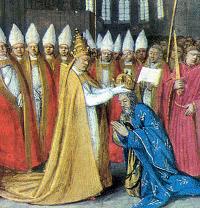
Indications of the second and sixth ray are, however, present from both biographical reports and from his chart. Sun/Venus and Sun/Jupiter conjunctions would both reinforce the heart-line energy and, in general, the second ray. Sixth ray energy was also present, reinforced through the wide Mars/Neptune conjunction and Vesta/MC conjunction.. The seventh ray would also be powerful as seventh ray Uranus was angular.
It is to be noted that Chiron (the wound) conjuncts a retrograde Mercury in Pisces. This gives subtlety of thought (perhaps along the fourth ray line), but also a potential sense of inadequacy (well concealed). It could have contributed to his high estimation of scholars and artists – a kind of compensation. Perhaps Charlemagne had certain fears in relation to verbal expression and compensated for this by encouraging it in others.
Accounts of his personality present him as a tall (Sun conjunct Jupiter, height-inducing Uranus angular at the seventh house cusp), broad-shouldered (Leo Rising, Sun conjunct Jupiter), a figure of good proportions (Sun conjunct Venus, giver of beauty and proportion) but with a slightly protruding belly (Leo, again), and a voice higher than one might expect in such an imposing figure (Mars, the ruler of the Aries Sun is placed in Gemini, ruled by high-pitched Mercury, itself placed in Pisces – a placement which affects the voice by reducing its resonance.). He was also, so the account runs, constantly plagued by fevers which would not be surprising for one with so many fire signs.
Charlemagne has been celebrated, romanticized and “lionized” (Leo, Ascendant) far beyond the reality of his true character, though doubtless he was a great man. He contained many contradictions (perhaps the indication of a fourth ray in the mind), though under the Law of Synthesis he attempted to “contain” those contradictions and harmonize them within limits. He had both personal piety and humility, as priestly, reverent Vesta on the MC and a disciplining Capricorn Moon near the cusp of the serving sixth house could suggest.
Yet he could be rough and brutal forcing those he conquered to convert to Christianity (sixth ray strong in the personality and Pluto in the third house of mind opposing the conjunction of faith – Sun/Jupiter in the ninth, Mars in Gemini “forcing thought of a particular kind” i.e., “forced conversions”.). His longest and most bloody wars were against the pagan Saxons. Subdued and forced to convert. they later rose again in rebellion; the punishment meted out by the victorious Charlemagne was terrible. On one occasion 4500 Saxons were executed en masse (a period of time during which cruel Pluto, natally square his Capricorn Moon, was also transiting that Moon.).
He had an indomitable will power (the gift of his three major signs, Aries, Leo and Capricorn) but also a sense of religious mission, the result of a powerful sixth ray (reinforced by a wide Mars/Neptune conjunction) with Mars trine Pluto, but also linking him to the second ray of Love-Wisdom (perhaps the primary ray of the spirit). While his manners were often rough, he quested after intellectual growth. For all strength on the field of battle, and refusal to relent in relation to his enemies, still, his rectitude and justness could not be doubted.
The chart chosen for Charlemagne (by Marc Penfield), though speculative with respect to the time, has much to recommend it and emphasizes admirably the main features of his life and character. At the time that he was crowned “Holy Roman Emperor” (and, even, perhaps anointed), by Pope Leo III (the period of his second Saturn return, when merit is realized), transiting Jupiter in Pisces (symbol of the Pope) was conjuncting his progressed Vertex (point of fate), and there had been just two weeks earlier an eclipse on his natal Vertex. On that Christmas day in 800, the transiting Moon was also in Pisces.
In attempting to confirm that a likely chart is being used, we turn to the Vertex. The Vertex point is an angle of the chart and thus very time-sensitive. The occurrence of important astrological events involving the Vertex at the times when those events actually occurred, indicate the reasonableness of this chart. As well, transiting Uranus was conjuncting the IC (another time-sensitive point). Progressing Jupiter, with its uplifting effect, was also very close to the MC. Charlemagne received a great elevation in status from this Coronation, which held before Europe a vision of union and empire which a thousand years later inspired the ambitions of Napoleon who sought to create a kind of replica of the Holy Roman Empire.
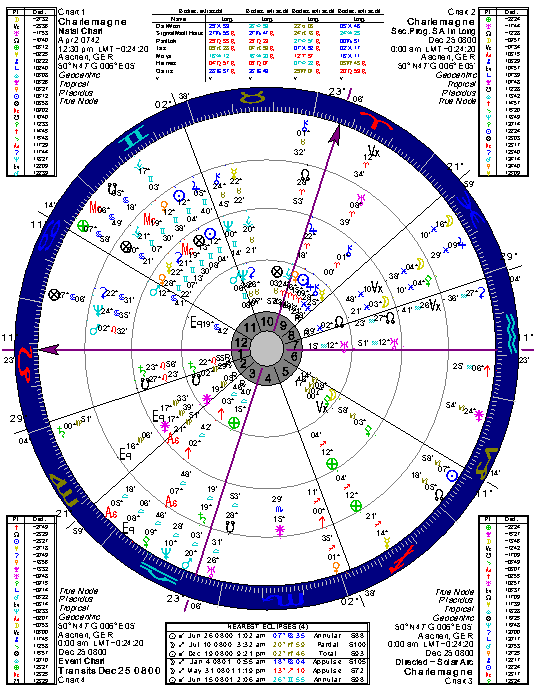
The Piscean influence at this climactic moment was very strong, as the progressing Moon had just entered Pisces and transiting Jupiter was in that sign, conjuncting Charlemagne’s Vertex. Certainly, Charlemagne (though ostensibly holding temporal power over the Church) sought to cooperate with and strengthen the Church of Rome (and for this he was handsomely rewarded). Throughout Medieval Europe, Charlemagne (called by a poet, the “King-Father of Europe”) was considered the prototype of a Christian king and emperor. Something other than the self-glorifying egotism commonly found in those upon the first ray was at work.
The fixed stars, the testimony of which is so often invoked in relation to kings and those in positions of great power, are very indicative. The Sun (already exalted in Aries) is parallel the powerful star Altair, indicating strength and courage to go forward in life, to seize the moment. It also may indicate aggressive action. As Altair is in the Eagle, it confers the power to aspire and to rise above ordinary accomplishment. The Sun is even more closely parallel to Betelgeuse (a star promoting major successes and good fortune), thus contributing to the successful outcome of so many of Charlemagne’s undertakings.
In occultism, the quality of Betelgeuse seems related to both the sixth and second rays; we recognize these rays in Charlemagne’s interest in both religion and education. Mercury (the esoteric ruler of the Aries Sun and dispositor of Mars) is conjuncting Alpheratz, a star expressing the urge for freedom and rapidity of movement, no doubt useful for one who has to “think fast” in military campaigns. Saturn is conjunct Zosma (a star related to victimization and persecution, or to those who fight for the victimized and persecuted. Many non-Christians must have felt persecuted and victimized by Charlemagne’s religious zeal, militarily enforced. On the other hand he was frequently seen coming to aid and rescue.
The most impressive aspects involving the stars show a great star of control, order, regulation and rulership, Regulus “the Heart of the Lion”, conjunct the Ascendant, and parallel the Ascendant as well. This is one of the “Four Royal Stars” and according to one modern star theorist (B. Brady), promises success if revenge is avoided. Charlemagne was a just man, but against perceived betrayal of trust and religious apostasy, he was merciless. The degree to which he built an empire and sought the widest possible control can be related to the prominence of Regulus. He did, however and unfortunately, engage in apparently vengeful acts which did not strengthen him, even within his court. Interestingly Ceres, the asteroid of nurturance is also parallel Regulus, and may indicate the manner in which he used his power to promote education and culture.
As for the monadic ray, one cannot with assurance speculate, and yet, there is a suggestion of a close relation to the Christ Force, and hence, the possibility of the second ray. His labors on behalf of education and culture also suggest the importance of the second ray.
Although the empire Charlemagne created lasted but one generation, his reputation became a huge force in the European psyche, and he was celebrated for hundreds of year in inspiring, romantic legends. After his death, he was beatified and in some churches he was honored as a saint. We see the astrological reason for his glorious reputation in the elevated Sun, Jupiter and Venus all conjunct in the ninth house near the MC. The Sun, of course, is ruler of the Leo Ascendant (associated with radiant identity)
Charlemagne, like many of the greatest warriors and conquerors, acted, however unconsciously, under the Shamballic Law of Synthesis. Others have attempted, though unsuccessfully, to unify the various peoples of Europe – Napoleon, for instance, and in a more limited way, Bismarck. The wild dreams of Hitler also encompassed this possibility. Charlemagne’s influence was far more benevolent. One can sense that his work was related to the Divine Plan – separating the Church of Rome from subservience to Byzantium, subduing pagan peoples in the interests of familiarizing them with Christ and his mission, and, in general spreading the influence and power of Christianity (an act required by the Plan during the Piscean Age). (A trans-Neptunian hypothetical planet Apollon, rising in his chart, is interesting in this respect.) In so many ways he became an Leonian example for rulers of far lesser stature who followed him. He is remembered as a noble man (higher Leo), not mean or petty in his spirit.
Although he was bold, confident, and self-assured, he was by no means a selfish egotist. He recognized a power higher than his own and maintained an attitude of humility in relation to that power. As a unifier of the Europe – intellectually, religiously and politically – he holds an unparalleled position. Though his achievements could not last under the subsequent leadership of lesser men than himself, a great example had been set, and European rulers for the next millennium, though they could not live up to that example, at least had to reckon with it.
Michael D. Robbins © 2003.

